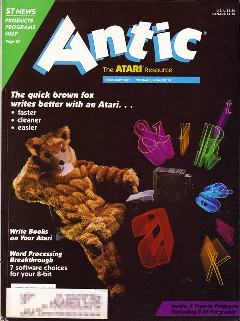Antic (magazine): Difference between revisions
| Line 4: | Line 4: | ||
==History== |
==History== |
||
NASA programmer Jim Capparell was an early [[Atari 8-bit]] owner. He quit his job on 15 January 1982 to found a magazine for the computer, named after the [[ANTIC]] graphics chip. Companies such as [[On-Line Systems]], [[Broderbund]], and [[Synapse Software]] agreed to purchase advertising in the new publication, and Capparell's staff distributed the first issue of 30 pages at the March 1982 [[West Coast Computer Faire]]. By Christmas 1983 the magazine was 148 pages, but the popularity of low-end, 8-bit home computers was declining and in 1984 Antic saw advertising sales drop by 50% in 90 days. Its Antic Catalog of [[public domain software]] helped the company avoid bankruptcy, and in 1985 it started ''II Computing'' for the [[Apple II series]].<ref name="bisson198605">{{cite news |
NASA programmer Jim Capparell was an early [[Atari 8-bit]] owner. He quit his job on 15 January 1982 to found a magazine for the computer, named after the [[ANTIC]] graphics chip. Companies such as [[On-Line Systems]], [[Broderbund]], and [[Synapse Software]] agreed to purchase advertising in the new publication, and Capparell's staff distributed the first issue of 30 pages at the March 1982 [[West Coast Computer Faire]]. By Christmas 1983 the magazine was 148 pages, but the popularity of low-end, 8-bit home computers was declining and in 1984 Antic saw advertising sales drop by 50% in 90 days. Its Antic Catalog of [[public domain software]] helped the company avoid bankruptcy, and in 1985 it started ''II Computing'' for the [[Apple II series]].<ref name="bisson198605">{{cite news|url=https://archive.org/stream/1986-05-anticmagazine/Antic_Vol_5-01_1986-05_Fourth_Anniversary_Issue#page/n15/mode/2up/search/raiders|title=Antic Then & Now|work=Antic|date=May 1986|accessdate=28 January 2015 | author=Bisson, Gigi | pages=16–23}}</ref> |
||
The first issue of ''Antic'' was published in April 1982. While it began as a bimonthly magazine, within a year it had gone monthly. The last issue was in June–July 1990. All told, 88 issues were published. A "Best of" book was also published. |
The first issue of ''Antic'' was published in April 1982. While it began as a bimonthly magazine, within a year it had gone monthly. The last issue was in June–July 1990. All told, 88 issues were published. A "Best of" book was also published. |
||
Revision as of 13:40, 4 May 2016

Antic ( ISSN 0113-1141) was a home computer magazine devoted to the Atari 8-bit computer line (Atari 400/800 and compatibles). It was published from April 1982 until June/July 1990. Antic published type-in programs (usually in BASIC), reviews, and tutorials, among other articles. Each issue contained one type-in game as "Game of the Month."
History
NASA programmer Jim Capparell was an early Atari 8-bit owner. He quit his job on 15 January 1982 to found a magazine for the computer, named after the ANTIC graphics chip. Companies such as On-Line Systems, Broderbund, and Synapse Software agreed to purchase advertising in the new publication, and Capparell's staff distributed the first issue of 30 pages at the March 1982 West Coast Computer Faire. By Christmas 1983 the magazine was 148 pages, but the popularity of low-end, 8-bit home computers was declining and in 1984 Antic saw advertising sales drop by 50% in 90 days. Its Antic Catalog of public domain software helped the company avoid bankruptcy, and in 1985 it started II Computing for the Apple II series.[1]
The first issue of Antic was published in April 1982. While it began as a bimonthly magazine, within a year it had gone monthly. The last issue was in June–July 1990. All told, 88 issues were published. A "Best of" book was also published.
Its main rival in the United States was ANALOG Computing, another long-lived magazine devoted to the Atari 8-bit line. A lesser rival was the short lived Hi-Res Magazine.
In 1985 Antic began ST Resource, a section of the magazine devoted to the Atari ST line.[1] In 1986 it began STart Magazine for the computer. The daughter magazine would outlive its parent by about a year. When Antic ended, it continued as a section of STart, appearing in six more issues.
Typo
One feature of Antic magazine was a program called TYPO ('Type Your Program Once', and a play on typographical error). This was a program that generated a checksum for each Atari BASIC line entered in a program. By comparing each line's checksum with that printed in the magazine, the reader could be sure they typed the BASIC source correctly. TYPO was later succeeded by TYPO II, a smaller, faster program.
Versions of TYPO were also published and used (with permission) by Page 6 magazine.
See also
- Antic Software – The software company founded by Antic.
References
- ^ a b Bisson, Gigi (May 1986). "Antic Then & Now". Antic. pp. 16–23. Retrieved 28 January 2015.
External links
- Antic Magazine – At the Classic Computer Magazine Archive
- Antic at the Internet Archive
- The Antic Magazine Library at the Centre for Computing History
